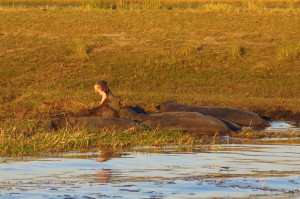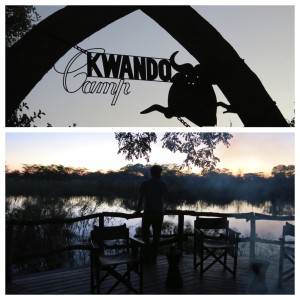Real World/Road Rules: Africa
by Dave
July 16 – 22
This is the true story… of seven strangers one couple… picked who chose to live in a house truck… work drove 2,500 miles together and have their lives taped photographed… to find out what happens… when people stop being polite completely run out of ANYTHING new to talk about… and start getting real…
So we drove a pickup truck for two weeks across rural Africa (EDITOR’S NOTE: So we’re going with “rural” are we? That one word…), camped on the roof of it and saw animals in the wild.
Needless to say, it was an amazing two weeks. I could cut this post off at that and then just post a ton of pics, but let’s take a quick collective step backwards and explain a few things first, shall we?
When planning long-term travel on a trip like this the first inclination was to pick a few places that we knew would be hardest to return to later in life. At or near the top of this list was Africa. And you’re not gonna not go on a safari if you have a trip to Africa, amiright or amiright? Once we established that, it was a matter of picking how and where we’d do it. So, naturally, we spoke to some friends who have done this sort of thing before, and all signs pointed to self-drive.
Ryan and Laura over at Round We Go do a great job of weighing the pros and cons of doing a self-drive safari or joining a group safari, and they’d helped convince us that having some more control and privacy during the safari was the way to go. With that said, there were still some feelings of – how do I put this – holy-crap-what-about-all-the-wild-animals-that-can-maul-you-when-you-camp-in-Africa?!?!? Those feelings were shared with us by friends and family (hi, moms), but then I was all “I can choke out big cats, remember?” and all their fears were washed away people still laughed at me.
Things got started at Chobe National Park, where we spent two nights before the reality of living out of a truck would set in. We soaked up the comforts of our air conditioned room with a hot water shower and everything else you’d expect from any standard hotel experience. But the “standard hotel” experience stopped there. Our room was surrounded by all sorts of wildlife literally right outside our door. Upon check-in the woman at the front desk warned us to keep our doors shut because “the monkeys can be aggressive.” And they were. We also regularly saw many of Timone’s (mongooses) and Pumba’s (warthogs) relatives right out our window and on any stroll we took around the property.
Chobe National Park lays claim to having the densest population of elephants anywhere in the world. While they may rule the park, there are many more animals there, too, and we saw plenty of them on a river boat safari – elephants, hippos, cape buffalo, crocodile and all sorts of birds and antelope (EDITOR’S NOTE: Cue Dave’s happy dance. No really.). This was the first of many days where I felt like a kid in a candy store (EDITOR’S NOTE: SEE?? Dancing.). As we’ve touched on a couple times, I’ve been borderline embarrassingly excited about each animal sighting we’ve had, and it was only getting better, as you can see from the photos below:
And then it was time to hit the road. Our truck was dropped off, we got quick instructions on how to set up the rooftop tent and a few other particulars in the back, and then it was just going to be trial-by-fire from there.
Within a half hour of leaving the lodge, we got a quick reminder that this was going to be a road trip unlike any other we had been on – in the form of an enormous elephant crossing the road about a hundred yards ahead of us. In hindsight, I would have liked to have been closer, but instinct tends to take over when you see a 12 foot high elephant who tips the scales somewhere north of 10,000 lbs that’s at least twice the size of your vehicle, and I hit the brakes immediately (EDITOR’S NOTE: Guess who was screaming for him to get closer? I have no such instinct.).
Once we avoided the elephant collision (EDITOR’S NOTE: Lame.) and crossed the border into the Caprivi Strip area of Namibia, we quickly realized how remote everything would quickly become. Namibia has the second lowest population density of any country in the world (somewhere in a frozen yurt in Mongolia – the only country ahead of Namibia on that list – there are people nodding their heads, sympathizing with Namibians), and long, empty roads with wide, empty plots of land on both sides are the norm in this sparsely populated country just north of South Africa.
We spent the next four days logging a lot of driving time, rarely seeing other cars on the road. And those first four nights were split between three campsites where we got our camping legs under us. First order of business was mapping out our menu. As we rushed to beat the sunset to get to our first campsite, all we had time to pick up was white rice and some seasoning. So that was our dinner that first night. And our lunch the following day. As things progressed, we found a good groove of grilling sausages, sirloins and burgers over campfire to diversify our road warrior diet.
And then there was the tent. As you can see from the pictures, we’re not exaggerating when we said we slept on the roof of our truck. Although slightly cramped inside, it actually was not as bad as you’d think. Once inside we were serenaded to sleep each night by wildlife – whether it was hippos grunting in the Chobe River that was a stone’s throw away from the truck (maybe a bit further, but I have a really good arm…), elephants trumpeting across the river, lions growling in the distance, foxes or hyenas howling… you name it, we heard it. And we acted like we weren’t unnerved by it although you can’t help but be a bit on edge when you hear a 4-ton animal as aggressive as a hippo grunting while you’re attempting to catch some z’s.
On the way to our second campsite, we took our first self-guided drive through Mamili National Park. The park ranger (I use the term “ranger” loosely, as she seemed to have just rolled out of bed, still wearing pajamas as she filled out our permit for us) mentioned that she heard lions nearby overnight, so we were excited to get going. While the lions remained elusive, we did have close-enough encounters with a giraffe, a bunch of warthogs, a couple groups of impala, some monkeys and a couple herds of cape buffalo. It was a good drive.
And then we got stuck in the sand.
Mind you, we were in a game park loaded with large animals (some of them carnivorous) and had not seen another human for the hour or two since leaving the “ranger station.” So that’s what we were dealing with when our 4-wheel drive betrayed us (totally the truck’s fault, definitely not user error…) and buried our tires in the deep, soft stuff. After a good 20 minutes of digging some sand away from tires with our hands and a dustpan (a shovel would have been nice, but was nowhere to be found), we wedged some leftover firewood and some nearby sticks under each tire and tried to drive out, but it wasn’t happening. But as luck would have it, we were within walking distance to a small construction project with a handful of men working that morning. After convincing them to help dig us out with our winning personalities the promise of a hefty thanks-for-digging-us-out-of-a-potentially-life-threatening-situation “tip,” they expertly pushed the car to firmer ground.
(EDITOR’S NOTE: We did not photo-document this particular adventure as its contents were not appropriate for children. Or grandmothers.)
By the end of our time in the Caprivi strip, we got into a nice routine of unpacking and repacking the tent and our gear, and an even better routine of campfires, meat and beers under a sky of endless stars. We had found our sweet spot, but still had the biggest attraction of the trip ahead of us – Etosha National Park. (EDITOR’S NOTE: Happy dance.)



















